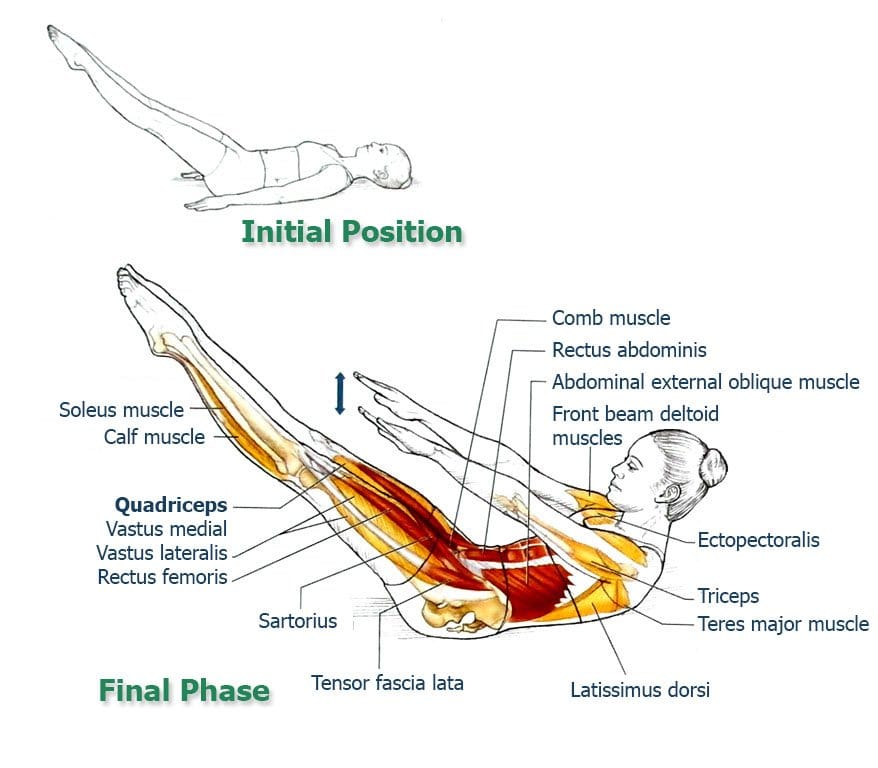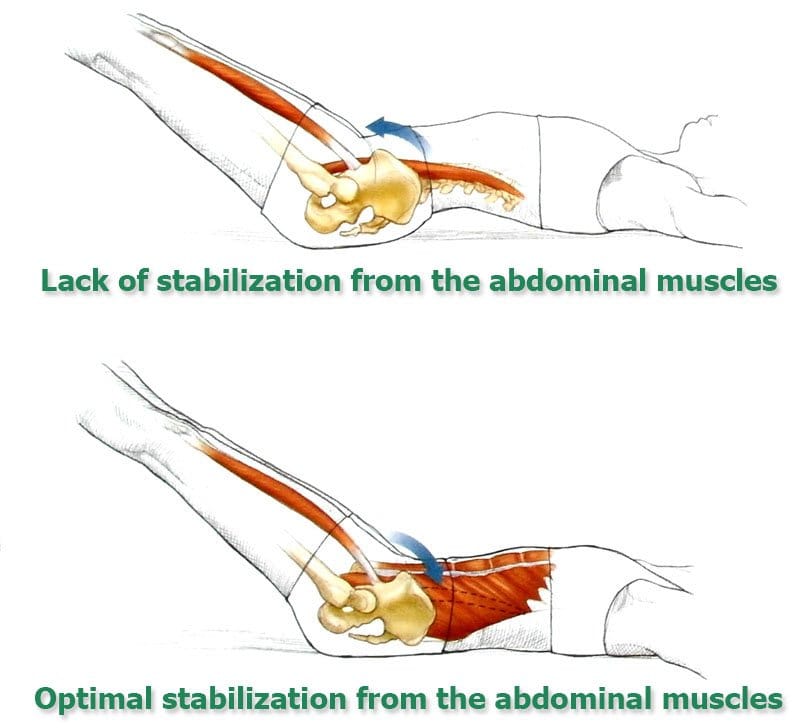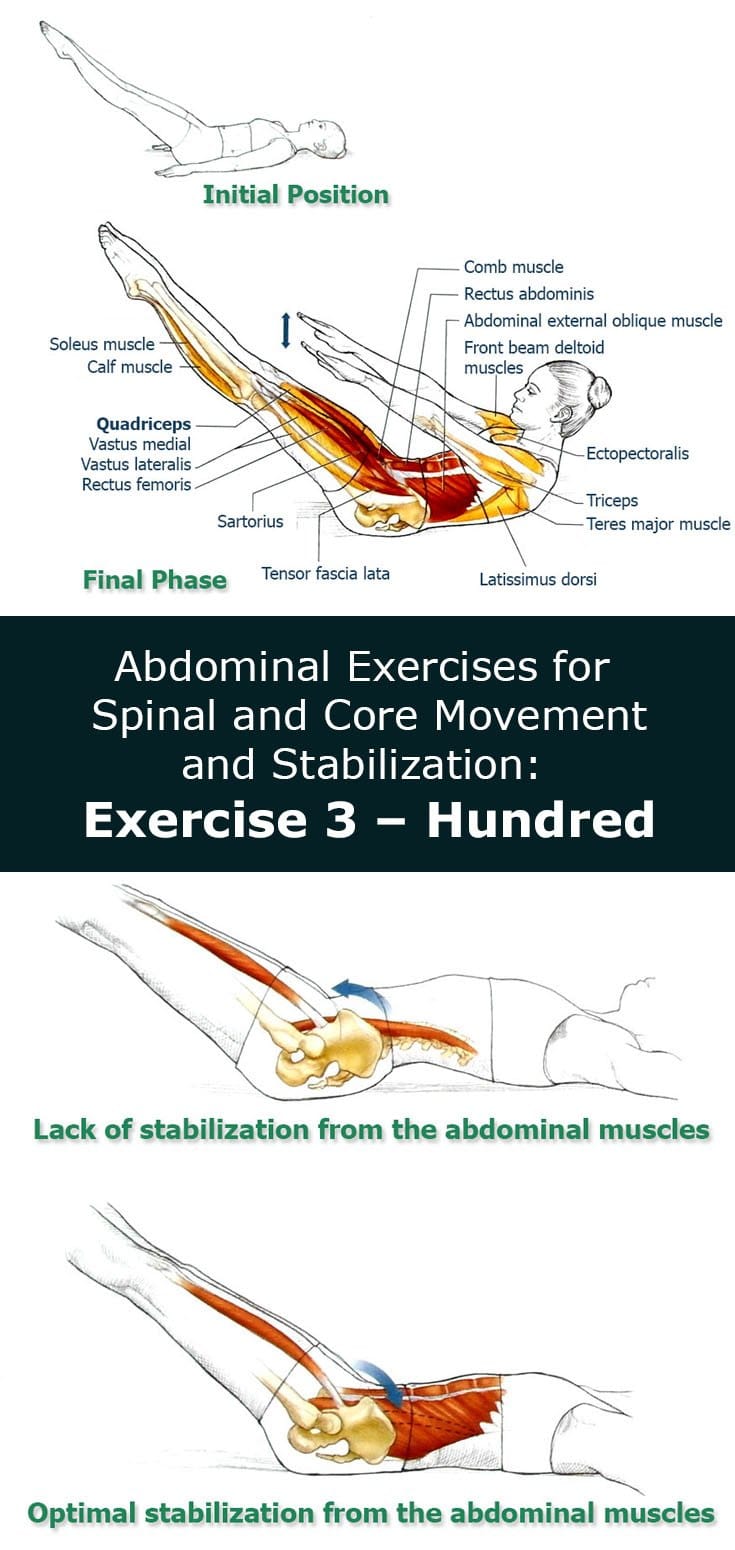Your core muscles are key to spine stability, as one of the main supporting blocks of the spine. People demonstrate greater improvement of spinal and core stabilization and have less back pain problems when they practise targeted exercises to strengthen their core muscles, like the Hundred.
The series so far:
- Exercise #1: Leg Circle
- Exercise #2: Roll-Up
- Exercise #3: Hundred (you are here)
- Exercise #4: One Leg Stretch
- Exercise #5: Stretching the Hamstring
- Exercise #6: Double Leg Stretch
- Exercise #7: Crisscross
- Final Exercise: Teaser
In today’s exercise, Hundred, the abdominals are used in an isometric manner to maintain a position of spinal flexion while the legs are held out straight in the air and off the mat.
Exercise 3 – Hundred

Initial position. Lie on your back with the legs straight and raised at about 60 degrees (or higher if necessary to maintain pelvic stability). Gently point the feet and keep the arms resting on the mat beside the body, with the palms facing down:
- Exhaling, draw the abdominals inward toward the spine and lift the upper trunk into a chest lift position. Take the arms forward to some 6 to 8 inches (15 to 20 cm) above the thighs, palms still facing down;
- Inhale and drive the arms slightly down and then up on each count for a total of 5 counts with active breathing (described in the Make Sure You section below). See the illustration;
- Exhale and drive the arms slightly down and then up on each count for a total of 5 counts with active breathing (described in the Make Sure You section below). Repeat this cycle 10 times or for 100 driving motions, as long as good form can be maintained. Lower the torso and bring the arms back down to the initial position.
Make Sure You:
- At the start of the exhale in the 2nd phase, draw the abdominals in toward the spine to prompt use of the transversus abdominis just before using the other abdominal muscles to flex the spine, while at the beginning of the motion the shoulder flexors raise the arms;
- To achieve the desired end position in the 2nd phase, focus on sustaining a firm abdominal contraction so that the lower back maintains contact with the mat and the pelvis remains steady. The hip flexors keep the angle on the raised legs, the knee extensors keep the knees straight and the ankle–foot plantar flexors the pointed position of the feet/toes. Furthermore, try to gently squeeze the inner thighs together to activate the hip adductors while stretching the legs out to create a long, arrow-like leg line;
- During the 3rd and 4th phase, you need to use active breathing. During active breathing, the breath is pushed out not only more forcefully during exhalation but also with a percussive emphasis as you actively contract the abdominals and particularly the internal intercostals in stages. On the inhale, the breath is drawn in with a percussive emphasis in stages, highlighting the external intercostals. This exercise, Hundred, requires five beats during inhalation and five beats during exhalation. Each beat represents further contraction of these muscles.
- Uphold a stationary deep C curve of the trunk as the arms drive in phases 3 and 4;
- Use the elbow extensors to keep the elbows straight, and stretch the fingertips forward;
- In phases 3 and 4, focus on isolating the movements of the arms to the shoulder joints, by using the muscles that run just below the armpits to encourage activation of the large latissimus dorsi and pectoralis major as the shoulder extensors and flexors work together to produce the quick driving movement of the arms.
- Mental image: imagine you are pressing the arms down against a trampoline and they are rebounding a few inches.
Additional Notes
The exercise Hundred offers a particularly difficult challenge to spinal and core stabilization. You have to maintain a constant position of spinal flexion while keeping the legs off the mat (with extended knees) as the arms repeatedly and energetically move. Because of these challenges, the exercise benefits individuals with adequate strength and skill. However, it is inappropriate and potentially risky for people lacking it. In fact, most people are not adequately prepared to perform this exercise with the legs held near to the mat. By using the modifications mentioned below, you can progress slowly to a more challenging leg position.
One additional thing to note: the contraction of the hip flexors holds the legs off the mat against gravity. Because of the attachments of the hip flexors (especially the iliopsoas and rectus femoris) onto the spine and front of the pelvis, their contraction tends to cause the lower back to arch and the pelvis to tilt anteriorly unless a simultaneous abdominal stabilization is performed (see the illustrations).
Since both legs are off the mat and the knees are straight, the legs produce much greater torque. This requires a much stronger contraction of the hip flexors to keep the legs off the mat. It is also a greater challenge for the abs to achieve spinal and core stabilization and keep the lower back from arching. The closer the legs are to the mat, the greater the muscular force required to counter the weight of the legs and the greater the challenge of the exercise.

Modifications
You can start the exercise by holding your legs as close to a vertical angle as is necessary to allow you to maintain a stable pelvis and lower back. Then you can gradually lower the legs as stability improves. If your hamstrings are tight, you can first practice the exercise with the legs in tabletop position or with the knees bent and the feet flat on the mat.


